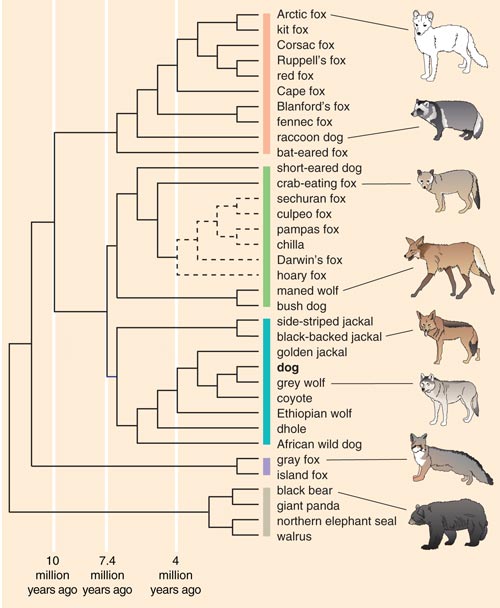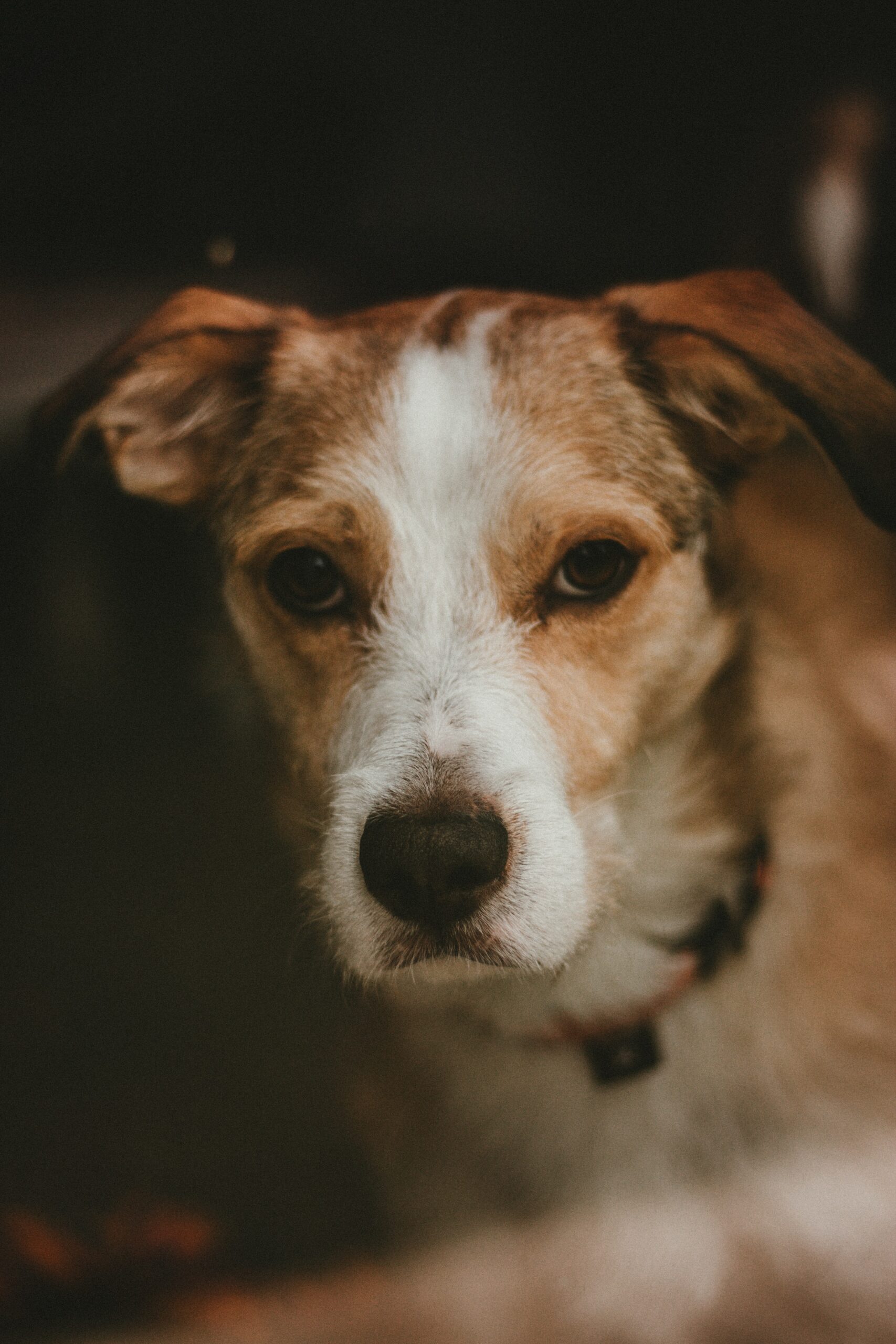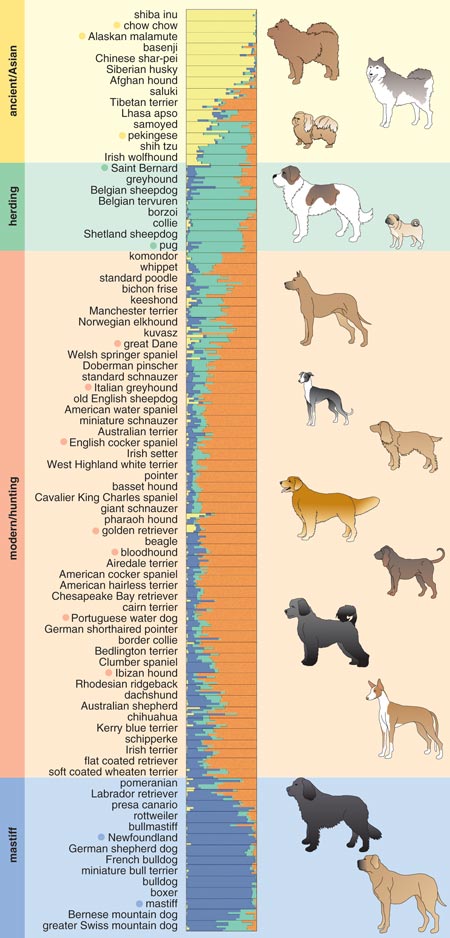
Hundar
Every breed has a special trait
Every breed has a special trait
Border Collies are highly trainable, Greyhounds love to chase, and German Shepherds make good guard dogs.While the environment plays a role, traits like these are highly heritable, according to a study of 101 dog breeds.
The work identifies 131 genetic variants associated with breed differences in behavior.
People have bred dogs for their looks and to perpetuate the traits they liked to see in different dog breeds.
The evolution of the dog had 3 main purposes: hunting, guarding, and companionship.

Research about dog breeds genes
In a new study, scientists from Arizona and Princeton University have shown there is a strong connection between a dog's breed and their genetics that influence their behavior: for example, chasing another animal and aggression towards strangers.
Dogs present a good model for understanding what portion of the variation in their behavior is attributable to differences in genetics, and how much to their environment and experiences,
says Snyder-Mackler, a researcher at the University of Washington.
Research about dog breeds genes
In a new study, scientists from Arizona and Princeton University have shown there is a strong connection between a dog's breed and their genetics that influence their behavior: for example, chasing another animal and aggression towards strangers.
Dogs present a good model for understanding what portion of the variation in their behavior is attributable to differences in genetics, and how much to their environment and experiences,
says Snyder-Mackler, a researcher at the University of Washington.

Genes can influence dog's behavior
The fact that genes can influence one's behavior has always been hard to support with facts because behaviors are complex, and traits such as aggression, anxiety, or chasing impulses that dogs have, are governed by multiple genes.
Dog breeds have been highly inbred, which made it easier for the researcher to study this phenomenon.
A dog breed's particular behavior, which is different from the others makes it easier to study the genetic variations and compare breed's genomes between each other.
With the help of the information from the C-BARQ (Canine Behavioral Assessment and Research Questionnaire-50,000 dog owners gave information about their pets),
the researcher found out that 14 behavioral factors about each dog can give measurements about their aggression, excitability, energy level, and predatory behavior.
For this study, the researchers pulled 14,020 of those entries that included information about purebred dogs.
To look for associations with genetics, they borrowed data from two earlier studies, together representing 5,697 dogs, for which 172,000 points in the genome had been sequenced.
Genes can influence dog's behavior
The fact that genes can influence one's behavior has always been hard to support with facts because behaviors are complex, and traits such as aggression, anxiety, or chasing impulses that dogs have, are governed by multiple genes.
Dog breeds have been highly inbred, which made it easier for the researcher to study this phenomenon.
A dog breed's particular behavior, which is different from the others makes it easier to study the genetic variations and compare breed's genomes between each other.
With the help of the information from the C-BARQ (Canine Behavioral Assessment and Research Questionnaire-50,000 dog owners gave information about their pets),
the researcher found out that 14 behavioral factors about each dog can give measurements about their aggression, excitability, energy level, and predatory behavior.
For this study, the researchers pulled 14,020 of those entries that included information about purebred dogs.
To look for associations with genetics, they borrowed data from two earlier studies, together representing 5,697 dogs, for which 172,000 points in the genome had been sequenced.

They discovered that half of the variation in the 14 measured behaviors among different dog breeds can be attributed to genetics.
Some of the dog breeds' behaviors are most likely influenced by their genetics and not by the environment, such as trainability, predatory behavior, aggression towards strangers, and attention requirements.
Genetics explained 60 to 70 percent of the variation among dog breeds.

They discovered that half of the variation in the 14 measured behaviors among different dog breeds can be attributed to genetics.
Some of the dog breeds' behaviors are most likely influenced by their genetics and not by the environment, such as trainability, predatory behavior, aggression towards strangers, and attention requirements.
Genetics explained 60 to 70 percent of the variation among dog breeds.
Dog breeds have different traits due to genetics
So for trainability, you're thinking of breeds like Border Collies that have to respond to human signals to accomplish complicated tasks;
for chasing behavior you can think of something like a Greyhound, which is innately predisposed to chase anything that runs;
and for stranger-directed aggression, you might focus on some of the guard dog breeds that are highly protective and tend to respond in a hostile way to unfamiliar people.
Some of this was located in genes that influence the behavior, including in humans.
The genes are more likely to be depicted in the brain area and not in other tissue parts of the body.
Studying the new sequence of the canine genome shows how tiny genetic changes can create enormous variation within a single species.
Dog breeds have different traits due to genetics
So for trainability, you're thinking of breeds like Border Collies that have to respond to human signals to accomplish complicated tasks;
for chasing behavior you can think of something like a Greyhound, which is innately predisposed to chase anything that runs;
and for stranger-directed aggression, you might focus on some of the guard dog breeds that are highly protective and tend to respond in a hostile way to unfamiliar people.
Looking for genetic variants for different dog breeds, the researchers have found 131 variants connected to these behaviors.
Some of this was located in genes that influence the behavior, including in humans.
The genes are more likely to be depicted in the brain area and not in other tissue parts of the body.
Studying the new sequence of the canine genome shows how tiny genetic changes can create enormous variation within a single species.

„Dog genome project”
On the other hand, in the early 1990s, another dog project was launched called the „dog genome project”, inspired by the scientist's desire to find the genes that influenced the health problems of pure breed dogs.
Most dog breeds only exist for a few hundred years, so they have a limited genetic diversity, being created from a small base of individuals, that were closely related.
Also, they often experienced „population bottlenecks” ( which means only the strongest and most able ones survived after a series of natural disasters, great hunger, or human activities).
This resulted in a bigger probability of genetic disease in pure breeds, in comparison with mixed breeds.
Scientists have been motivated to use dog populations to find genes for diseases that affect both humans and dogs, including cancer, deafness, epilepsy, diabetes, cataracts, and heart disease.
In doing so they can simultaneously help man and man's best friend.
„Dog genome project”
On the other hand, in the early 1990s, another dog project was launched called the „dog genome project”, inspired by the scientist's desire to find the genes that influenced the health problems of pure breed dogs.
Most dog breeds only exist for a few hundred years, so they have a limited genetic diversity, being created from a small base of individuals, that were closely related.
Also, they often experienced „population bottlenecks” ( which means only the strongest and most able ones survived after a series of natural disasters, great hunger, or human activities).
This resulted in a bigger probability of genetic disease in pure breeds, in comparison with mixed breeds.
Scientists have been motivated to use dog populations to find genes for diseases that affect both humans and dogs, including cancer, deafness, epilepsy, diabetes, cataracts, and heart disease.
In doing so we can simultaneously help man and man's best friend.
The results of the dog's genome project
The dog genome project's purpose was to create a genetic map that could track the dog's genome.
Finally, in 2003, a partial sequence of a standard Poodle was produced that spanned nearly 80 percent of the 2.8 billion base pairs that make up the dog genome.
This was followed quickly by a concerted effort to fully sequence the Boxer genome, producing what is today the reference sequence for the dog.
By knowing what a gene does and what the family belongs to, scientists might be able to develop its track to see what will happen with it and also in the case it gets distorted.

The results of the dog's genome project
The dog genome project's purpose was to create a genetic map that could track the dog's genome.
Finally, in 2003, a partial sequence of a standard Poodle was produced that spanned nearly 80 percent of the 2.8 billion base pairs that make up the dog genome.
This was followed quickly by a concerted effort to fully sequence the Boxer genome, producing what is today the reference sequence for the dog.
By knowing what a gene does and what the family belongs to, scientists might be able to develop its track to see what will happen with it and also in the case it gets distorted.
Genetic history of dogs
Genetic history of dogs
The domestic dog
The domestic dog is the most evolved species of the Canidae family.
In this family, there are three phylogenetic groups: the domestic dogs that have the grey wolf (coyote and jackal) as a common ancestor.
It is believed that dogs have appeared around 40,000 years ago and the first domestication has been taken place in eastern Asia.
Most modern breeds that we see today are the product of the human breeding that has taken place 200-300 years ago, many of them developed in Europe, in the 1800s.
The Greyhound and Pharaoh Hound are the most interesting to study since is unclear if they are representations of the depicted ancient breeds or if we can use the modern breeds to trace their ancestors.
The domestic dog
The domestic dog is the most evolved species of the Canidae family.
In this family, there are three phylogenetic groups: the domestic dogs that have the grey wolf (coyote and jackal) as a common ancestor.
It is believed that dogs have appeared around 40,000 years ago and the first domestication has been taken place in eastern Asia.
Most modern breeds that we see today are the product of the human breeding that has taken place 200-300 years ago, many of them developed in Europe, in the 1800s.
The Greyhound and Pharaoh Hound are the most interesting to study since is unclear if they are representations of the depicted ancient breeds or if we can use the modern breeds to trace their ancestors.

What characterizes a dog breed?
The American Kennel Club (AKC) recognizes 155 breeds of dogs and newly created breeds are given this title; the question is though what characterizes a dog breed?!
Coat color, body shape and size, leg length, and head shape-all these traits, plus their genetics defines a dog breed.
For a dog to become a registered member in AKC, they must come from parents that have already been registered and so on, this is why dog breeds are generally limited with little to no option to introduce new
alleles (variations in the genome).
As a result, pure breed dogs are depicted by a reduced level of genetic diversity in comparison with mixed breeds.
Some breeds that originated from a reduced number of ancestors have encountered population bottlenecks (reduced population due to environmental effects such as floods, disease, fires, famines ), or are the result of an extreme number of litters from a show dog, which results in reduced genetic diversity.
What characterizes a dog breed?
The American Kennel Club (AKC) recognizes 155 breeds of dogs and newly created breeds are given this title; the question is though what characterizes a dog breed?!
Coat color, body shape and size, leg length, and head shape-all these traits, plus their genetics defines a dog breed.
For a dog to become a registered member in AKC, they must come from parents that have already been registered and so on, this is why dog breeds are generally limited with little to no option to introduce new
alleles (variations in the genome).
As a result, pure breed dogs are depicted by a reduced level of genetic diversity in comparison with mixed breeds.
Some breeds that originated from a reduced number of ancestors have encountered population bottlenecks (reduced population due to environmental effects such as floods, disease, fires, famines ), or are the result of an extreme number of litters from a show dog, which results in reduced genetic diversity.

They also showed that the genetic variation between dog breeds is much greater than the variation within breeds.
Between-breed variation is estimated at 27.5 percent.
By comparison, genetic variation between human populations is only 5.4 percent.
Thus the concept of a dog breed is very real and can be defined not only by the dog's appearance but genetically as well.
They also showed that the genetic variation between dog breeds is much greater than the variation within breeds.
Between-breed variation is estimated at 27.5 percent.
By comparison, genetic variation between human populations is only 5.4 percent.
Thus the concept of a dog breed is very real and can be defined not only by the dog's appearance but genetically as well.
A computer program that identifies dog breeds by their genetic profile
In the second part of the study, the scientists wanted to determine whether or not they can identify each dog breed by its genetic profile.
In the computer program which was previously blinded ( didn't have any information about each breed's data) 99 percent of dogs were connected to their breed using only their DNA profile.
To establish the ancestry of various breeds, the scientists utilized a computer program to see which breeds were related.
The program identifies genetically distinct subpopulations within a group based on patterns of allele frequencies, presumably from a shared ancestral pool.
A computer program that identifies dog breeds by their genetic profile
In the second part of the study, the scientists wanted to determine whether or not they can identify each dog breed by its genetic profile.
In the computer program which was previously blinded ( didn't have any information about each breed's data) 99 percent of dogs were connected to their breed using only their DNA profile.
To establish the ancestry of various breeds, the scientists utilized a computer program to see which breeds were related.
The program identifies genetically distinct subpopulations within a group based on patterns of allele frequencies, presumably from a shared ancestral pool.

The results of the computer program
The results of the computer program
The result of 85 breeds came out in four groups :
- the first group was represented by dogs of Asian and African Origin ( older ancestry)-and also grey wolves
-the second group was represented by large Mastiff-type dogs ( with big heads and resilient, strong bodies)
-the third and fourth groups were represented by herding dogs and modern hunting dogs, such as terriers, hounds, and bird dogs.
„For about 75 percent of the genes, the homology (amount of similarity arising from shared ancestry) between the dog, human, and mouse genome is very high.”

The result of 85 breeds came out in four groups :
- the first group was represented by dogs of Asian and African Origin ( older ancestry)-and also grey wolves
-the second group was represented by large Mastiff-type dogs ( with big heads and resilient, strong bodies)
-the third and fourth groups were represented by herding dogs and modern hunting dogs, such as terriers, hounds, and bird dogs.
„For about 75 percent of the genes, the homology (amount of similarity arising from shared ancestry) between the dog, human, and mouse genome is very high.”

The size of the breed is determined by genes
The size of the breed is determined by genes
Insulin-like growth factor 1 ( IGF1) influences body size in humans and mice it's the gene that has led to the creation of small size dogs.
It has been observed a reduction in heterozygosity ( the possession of two different alleles of a particular gene or genes by an individual) over the IGF1 gene in small breeds and its near absence in giant breeds, indicating the fact that the mutation is ancient and it took place early in the domestic dog's history.
Insulin-like growth factor 1 ( IGF1) influences body size in humans and mice it's the gene that has led to the creation of small size dogs.
It has been observed a reduction in heterozygosity ( the possession of two different alleles of a particular gene or genes by an individual) over the IGF1 gene in small breeds and its near absence in giant breeds, indicating the fact that the mutation is ancient and it took place early in the domestic dog's history.
Another research in this area is referring to the whippet (small, slender crossbreed between a Greyhound and a Terrier or Spaniel, bred for racing) and a gene mutation in the myostatin ( a protein that acts as an inhibitor to the growth of muscle tissue).
The new mutation seemed to create the „bully” whippet phenotype. Individuals that have only one copy of the mutation are on average more muscular than others.
It has been tested if the fastest racer dogs carried one copy of this mutation and the results were indeed true ( 50% of them).
Although, the variant has been not discovered to exist in Greyhound breed or Bulldog breeds ( which have great muscles).
Myostatin mutation results in a faster dog
Another research in this area is referring to the whippet (small, slender crossbreed between a Greyhound and a Terrier or Spaniel, bred for racing) and a gene mutation in the myostatin ( a protein that acts as an inhibitor to the growth of muscle tissue).
The new mutation seemed to create the „bully” whippet phenotype. Individuals that have only one copy of the mutation are on average more muscular than others.
It has been tested if the fastest racer dogs carried one copy of this mutation and the results were indeed true ( 50% of them).
Although, the variant has been not discovered to exist in Greyhound breed or Bulldog breeds ( which have great muscles).

Genes are a great behavior predictor, although environment and training are equally important
Genes are a great behavior predictor, although environment and training are equally important
As a conclusion of this engaging research on dogs, they have all given an average result, which doesn't apply to all dog breeds, every dog being different.
Environment and training still have a great impact on a dog's behavior, regardless of its genes.
Of course, they can be a great predictor of the most obvious traits that he/she will have ( such as trainability, prey drive, aggression, friendliness, and attention requirements), this is why it's important to inform ourselves about the type of breed which is fitted best for our lifestyle and personality,
although we all know that every dog is beautiful and kind and that they always bring love to our homes and universe every day.
As a conclusion of this engaging research on dogs, they have all given an average result, which doesn't apply to all dog breeds, every dog being different.
Environment and training still have a great impact on a dog's behavior, regardless of its genes.
Of course, they can be a great predictor of the most obvious traits that he/she will have ( such as trainability, prey drive, aggression, friendliness, and attention requirements), this is why it's important to inform ourselves about the type of breed which is fitted best for our lifestyle and personality,
although we all know that every dog is beautiful and kind and that they always bring love to our homes and universe every day.

Until one has loved an animal, a part of one’s soul remains unawakened.
Anatole France
Until one has loved an animal, a part of one’s soul remains unawakened.
Anatole France



